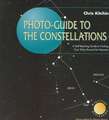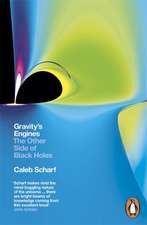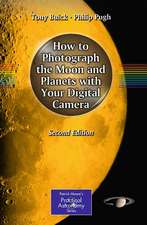One-Shot Color Astronomical Imaging: In Less Time, For Less Money!: The Patrick Moore Practical Astronomy Series
Autor L. A. Kennedyen Limba Engleză Paperback – 5 apr 2012
What is one-shot color imaging? Typically, astronomical cooled-chip CCD cameras record only one color at a time - rather like old-fashioned black & white cameras fitted with color filters. Three images are taken in sequence - in red, blue, and green light - and these are then merged by software in a PC to form a color image. Each of the three images must be taken separately through a suitable color filter, which means that the total exposure time for every object is more than tripled. When exposure times can run into tens of minutes or even hours for each of the three colors, this can be a major drawback for the time-pressed amateur.
"One-Shot Color Astronomical Imaging" describes the most cost-effective and time-efficient way for any amateur astronomer to begin to photograph the deep-sky.
Din seria The Patrick Moore Practical Astronomy Series
-
 Preț: 258.21 lei
Preț: 258.21 lei -
 Preț: 164.94 lei
Preț: 164.94 lei -
 Preț: 324.21 lei
Preț: 324.21 lei -
 Preț: 255.10 lei
Preț: 255.10 lei - 8%
 Preț: 581.98 lei
Preț: 581.98 lei -
 Preț: 159.16 lei
Preț: 159.16 lei -
 Preț: 282.38 lei
Preț: 282.38 lei -
 Preț: 308.55 lei
Preț: 308.55 lei -
 Preț: 309.87 lei
Preț: 309.87 lei -
 Preț: 332.98 lei
Preț: 332.98 lei -
 Preț: 276.91 lei
Preț: 276.91 lei -
 Preț: 243.94 lei
Preț: 243.94 lei -
 Preț: 183.40 lei
Preț: 183.40 lei -
 Preț: 378.09 lei
Preț: 378.09 lei -
 Preț: 302.20 lei
Preț: 302.20 lei -
 Preț: 210.01 lei
Preț: 210.01 lei -
 Preț: 212.68 lei
Preț: 212.68 lei -
 Preț: 271.39 lei
Preț: 271.39 lei -
 Preț: 252.91 lei
Preț: 252.91 lei -
 Preț: 281.95 lei
Preț: 281.95 lei -
 Preț: 289.85 lei
Preț: 289.85 lei -
 Preț: 218.84 lei
Preț: 218.84 lei -
 Preț: 282.38 lei
Preț: 282.38 lei -
 Preț: 128.86 lei
Preț: 128.86 lei -
 Preț: 301.10 lei
Preț: 301.10 lei -
 Preț: 204.78 lei
Preț: 204.78 lei -
 Preț: 307.44 lei
Preț: 307.44 lei -
 Preț: 303.07 lei
Preț: 303.07 lei -
 Preț: 258.83 lei
Preț: 258.83 lei -
 Preț: 155.25 lei
Preț: 155.25 lei -
 Preț: 193.97 lei
Preț: 193.97 lei -
 Preț: 208.26 lei
Preț: 208.26 lei -
 Preț: 279.09 lei
Preț: 279.09 lei -
 Preț: 303.51 lei
Preț: 303.51 lei -
 Preț: 277.54 lei
Preț: 277.54 lei -
 Preț: 208.51 lei
Preț: 208.51 lei -
 Preț: 214.86 lei
Preț: 214.86 lei -
 Preț: 304.58 lei
Preț: 304.58 lei -
 Preț: 220.57 lei
Preț: 220.57 lei -
 Preț: 157.32 lei
Preț: 157.32 lei -
 Preț: 275.98 lei
Preț: 275.98 lei -
 Preț: 288.98 lei
Preț: 288.98 lei -
 Preț: 261.49 lei
Preț: 261.49 lei -
 Preț: 279.09 lei
Preț: 279.09 lei -
 Preț: 160.82 lei
Preț: 160.82 lei -
 Preț: 327.01 lei
Preț: 327.01 lei -
 Preț: 254.90 lei
Preț: 254.90 lei -
 Preț: 304.38 lei
Preț: 304.38 lei -
 Preț: 256.84 lei
Preț: 256.84 lei
Preț: 207.64 lei
Nou
Puncte Express: 311
Preț estimativ în valută:
39.74€ • 43.15$ • 33.38£
39.74€ • 43.15$ • 33.38£
Carte disponibilă
Livrare economică 01-15 aprilie
Preluare comenzi: 021 569.72.76
Specificații
ISBN-13: 9781461432463
ISBN-10: 1461432464
Pagini: 255
Ilustrații: XX, 191 p. 98 illus., 20 illus. in color.
Dimensiuni: 155 x 235 x 20 mm
Greutate: 0.32 kg
Ediția:2012
Editura: Springer
Colecția Springer
Seria The Patrick Moore Practical Astronomy Series
Locul publicării:New York, NY, United States
ISBN-10: 1461432464
Pagini: 255
Ilustrații: XX, 191 p. 98 illus., 20 illus. in color.
Dimensiuni: 155 x 235 x 20 mm
Greutate: 0.32 kg
Ediția:2012
Editura: Springer
Colecția Springer
Seria The Patrick Moore Practical Astronomy Series
Locul publicării:New York, NY, United States
Public țintă
Popular/generalCuprins
Digital Imaging.- One-Shot Color vs. Multiple Color Filter Exposures.- Evaluating Your Existing Equipment.- Choosing the Right Stuff.- Finding Targets to Image.- Setting Up Your Imaging Confirmation.- Polar Alignment, Focusing, and Framing.- Calibration.- Taking Exposures and Auto Guiding.- Stack 'Em Up.- Histogram Display.- Image Processing and Enhancement.- Displaying Your Images.- More Things You Can Do.- Additional Resources.
Recenzii
From the book reviews:
“The book contains lots of good advice and tips for any imager – even if you have a mono CCD camera. This is a great book for imaging as it takes through all the steps required in order to generate pleasing images. One Shot Colour Astronomical Imaging is thoroughly recommended if you want a good overview of how to get into imaging no matter whether you have a mono or colour camera.” (astronomylog.co.uk, July, 2014)
“There is a way to save time by using a so-called one-shot color CCD camera … . This book is about using such a camera, the equipment needed, the set-up for imaging, some tips and suggestions … it is an important guide to getting started with this kind of equipment. The book would also be of interest to those astrophotographers who are just getting started in the field … . Very useful and concise, and also inspirational.” (Kadri Tinn, AstroMadness.com, July, 2014)
“The book contains lots of good advice and tips for any imager – even if you have a mono CCD camera. This is a great book for imaging as it takes through all the steps required in order to generate pleasing images. One Shot Colour Astronomical Imaging is thoroughly recommended if you want a good overview of how to get into imaging no matter whether you have a mono or colour camera.” (astronomylog.co.uk, July, 2014)
“There is a way to save time by using a so-called one-shot color CCD camera … . This book is about using such a camera, the equipment needed, the set-up for imaging, some tips and suggestions … it is an important guide to getting started with this kind of equipment. The book would also be of interest to those astrophotographers who are just getting started in the field … . Very useful and concise, and also inspirational.” (Kadri Tinn, AstroMadness.com, July, 2014)
Notă biografică
Having discovered an unknown passion for astronomy in college, L. A. Kennedy has been an avid amateur astronomer and astro-imager ever since. In addition to writing his book, he is very active in sharing his knowledge and passion for astrophotography with interested people at schools, colleges, and in private settings. He currently lives and images under the light-polluted skies of southeastern Michigan.
Kennedy is a purchasing and supply-chain management professional by trade, with years of experience in several industries. He has a proven ability to find ways to save both time and money in any situation. Applying this ability to the field of astrophotography has allowed amateur astronomers across the globe to benefit from his insights into more efficient and cost-effective astronomical imaging techniques.
Kennedy has been using one-shot color imaging equipment since the earliest one-shot color charge-coupled devices (CCD's) became available to the general public. For many years he has been displaying high-quality, color images of deep-space objects for friends and family on his personal website. Through his business website, www.digitalspaceimages.com, he has published and sold his astrophotography images all over the world.
Kennedy is a purchasing and supply-chain management professional by trade, with years of experience in several industries. He has a proven ability to find ways to save both time and money in any situation. Applying this ability to the field of astrophotography has allowed amateur astronomers across the globe to benefit from his insights into more efficient and cost-effective astronomical imaging techniques.
Kennedy has been using one-shot color imaging equipment since the earliest one-shot color charge-coupled devices (CCD's) became available to the general public. For many years he has been displaying high-quality, color images of deep-space objects for friends and family on his personal website. Through his business website, www.digitalspaceimages.com, he has published and sold his astrophotography images all over the world.
Textul de pe ultima copertă
Anyone who has seen recent pictures of the many wondrous objects in space has surely been amazed by the stunning color images. Trying to capture images like these through your own telescope has always seemed too time-consuming, expensive, and complicated. However, with improvements in affordable, easy-to-use CCD imaging technology, you can now capture amazing images yourself. With today's improved "one-shot" color imagers, high-quality images can be taken in a fraction of the time and at a fraction of the cost, right from your own backyard.
This book will show you how to harness the power of today's computerized telescopes and entry-level imagers to capture spectacular images that you can share with family and friends. It covers such topics as
- evaluating your existing equipment, choosing the right imager, finding targets to image, telescope alignment, focusing and framing the image, exposure times, aligning and stacking multiple frames, image calibration, and enhancement techniques!
- how to expand the number of objects you can "see" with your telescope, especially in the light-polluted skies near urban areas
- image-processing routines specific to today's popular one-shot color imagers
This book will show you how to harness the power of today's computerized telescopes and entry-level imagers to capture spectacular images that you can share with family and friends. It covers such topics as
- evaluating your existing equipment, choosing the right imager, finding targets to image, telescope alignment, focusing and framing the image, exposure times, aligning and stacking multiple frames, image calibration, and enhancement techniques!
- how to expand the number of objects you can "see" with your telescope, especially in the light-polluted skies near urban areas
- image-processing routines specific to today's popular one-shot color imagers
Caracteristici
Describes the most cost-effective and time-efficient way for any amateur astronomer to begin to photograph the deep-sky Looks at all the basics: what equipment will be needed, how color imaging is carried out, and what specific processing steps need to be followed Provides the specific methodology that must be used in order to turn raw color shots into magnificent color images









